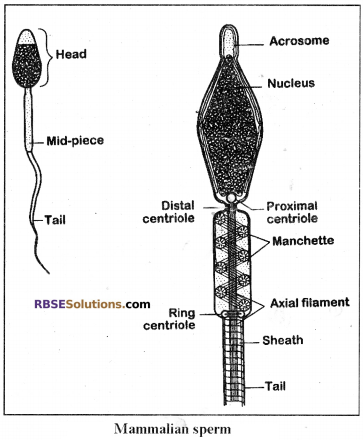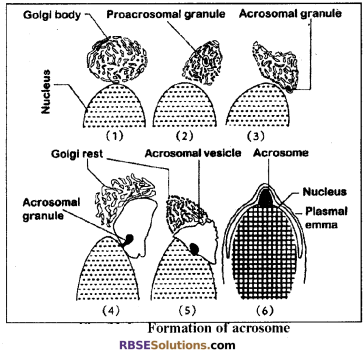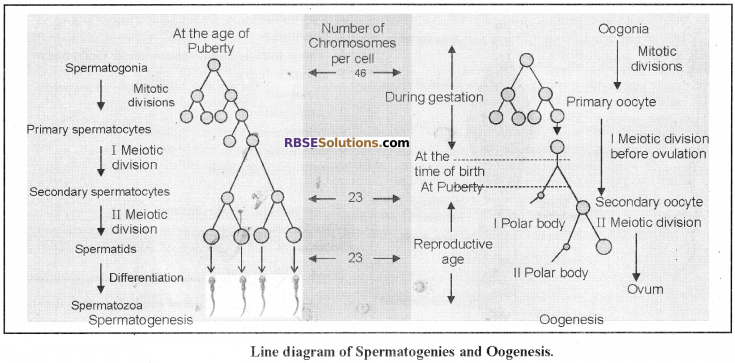Rajasthan Board RBSE Class 12 Biology Chapter 31 Man-Gametogenesis
RBSE Class 12 Biology Chapter 31 Multiple Choice Questions
Question 1.
The discharge of mature ovum from over is called –
(a) Implantation
(b) Fertilization
(c) Ovulation
(d) Parturition
Answer:
(c) Ovulation
Question 2.
How long spermatozoa survive after the entry in the Vagina?
(a) 1 – 2 days
(b) 3 – 4 days
(c) 5 – 10 days
(d) 1 week
Answer:
(a) 1 – 2 days
![]()
Question 3.
Breakdown of an acrosomal membrane in mammalian sperm is called –
(a) Activation
(b) Capacitation
(c) Agglutination
(d) Fertilization
Answer:
(b) Capacitation
Question 4.
Which of the following is immortal?
(a) Glomerular cell
(b) Germ cell
(c) Pituitary cell
(d) Somatic cell
Answer:
(b) Germ cell
Question 5.
Which of the following sperm development stage phase is not found in the egg development?
(a) Formation of Polar body
(b) Growth phase
(c) Multiplication phase
(d) Spermiogenesis
Answer:
(d) Spermiogenesis
![]()
Question 6.
During oogenesis following stage is found –
(a) Multiplication phase
(b) Growth phase
(c) Maturation phase
(d) All of the above
Answer:
(d) All of the above
Question 7.
Formation of eggs is called as –
(a) Oviparity
(b) Oogenesis
(c) Ovulation
(d) Gametogenesis
Answer:
(b) Oogenesis
Question 8.
Configuration of fibers in the tail of spermatozoan is:
(a) 2 (singlet) + 9 (doublet)
(b) 9 (singlet) + 9 (doublet)
(c) 9 (singlet) + 2 (doublet)
(d) 9 (singlet) + 9 (doublet) + 2 (singlet)
Answer:
(d) 9 (singlet) + 9 (doublet) + 2 (singlet)
Question 9.
At which stage polar body form –
(a) Regeneration
(b) Spermatogenesis
(c) Oogenesis
(d) Fertilization
Answer:
(c) Oogenesis
![]()
Question 10.
How many ova are formed from a primary oocyte?
(a) One
(b) Two
(c) Eight
(d) Four
Answer:
(a) One
RBSE Class 12 Biology Chapter 31 Very Short Answer Type Questions
Question 1.
What kind of eggs are found in placental mammals?
Answer:
Alecithal.
Question 2.
Which part of sperm head comes in contact with egg at the time of fertilization?
Answer:
Acrosome.
Question 3.
Which cell do organelles participate in the formation of the middle part of sperm?
Answer:
Mitochondria & Centrosome.
![]()
Question 4.
Which cells are formed as a result of the second maturation division during spermatogenesis?
Answer:
Spermatid.
Question 5.
Where Bar body is found?
Answer:
In the nucleus of cells of woman.
Question 6.
Why more spermatozoa are formed as compared to ova?
Answer:
One spermatogenesis forms 4 sperms were as one oogenesis forms only one ovum.
![]()
Question 7.
Name the hormones found on the surface of the egg.
Answer:
Gynogamone & Fertilizin.
RBSE Class 12 Biology Chapter 31 Short Answer Type Questions
Question 1.
Describe the structure of human sperm.
Answer:
Structure of Human Sperm:
- The male gamete is called as spermatozoon or sperm. It is a single cell structure and it bears a haploid set of chromosomes in the nucleus.
- Human sperm has a head, neck, mid-piece & tail.
Head:
- It is the anterior part of the sperm. Its shape varies from species to species.
- The anteriormost part of the head is occupied by the acrosome.
- The acrosome is formed by the Golgi-body and it is bounded by a unit membrane.
- It is full of sperm lysins & it helps in fertilization.
- There is a nucleus just behind the acrosome which is slightly elongated and its posterior end has a notch.
- The nucleus has a haploid set of chromosomes which have protamines in addition to DNA.
- The sperms of some species have a vacuole-like structure between the acrosome and nucleus which is called as a perforator.
- The posterior notch of the nucleus harbours a proximal centriole which is to be contributed to the egg at the time of fertilization.
- It helps at the beginning of the first cleavage.
Neck:
- It is a small part which connects the head to the mid-piece.
- It bears a distal centriole which remains at 90° to the proximal centriole.
- The distal centriole gives rise to an axial filament which extends throughout the length of mid-piece & tail.
- It exhibits a fibrilar arrangement of 9 (doublet) + 2 (singlet).
Middle piece:
- In the middle piece, the axial filament is surrounded by a sheath called manchette.
- The manchette is made up of nebenkern (fused mitochondria) and little condensed cytoplasm.
- In the sperms of some species, the posterior end of the middle piece may have a ring centriole. Its role is not clear.
Tail:
- In the tail, the axial filament is covered by a sheath which is made up of 9 (singlet) fibres.
- This sheath is absent around the terminal end of the tail.
- The whole sperm is bounded by a plasmalemma.
- Most of the sperms are mono-flagellated.

![]()
Question 2.
Describe the formation of Acrosome.
Answer:
Formation of Acrosome:
- The anteriormost part of the sperm is called an acrosome.
- It is formed by the Golgi body during the spermiogenesis.
- Firstly, one of the vacuoles of the Golgi body develops an acrosomal granule.
- Gradually, the acrosomal granule accumulates lytic enzymes and forms a cap-like structure on the anterior end of the nucleus.
- Soon this cap gets bounded by a single unit plasma membrane and forms an acrosome.
- The rest parts of the Golgi body are lost in the form of Golgi rest.
Question 3.
Write a brief note on three stages of gametogenesis.
Answer:
Gametogenesis includes spermatogenesis & oogenesis. It includes three phases –
- Multiplication Phase – In this phase, the diploid germ cell divides by mitosis to form diploid oogonia in oogenesis & spermatogonia in spermatogenesis.
- Growth Phase – This phase involves only grow in size. It is the longest phase. It results in the formation of the primary oocyte in oogenesis & primary spermatocyte
in spermatogenesis. - Maturation Phase – This phase involves meiosis division and it is divided into two phases –
- Maturation – I – The diploid primary oocyte/ spermatocyte divides by meiosis-I to form two haploid secondary spermatocytes in spermatogenesis and in oogenesis one secondary oocyte & one polar body is formed.
- Maturation – II – In spermatogenesis, the two secondary spermatocytes divide by meiosis-II to form four haploid spermatids which finally convert into four haploid sperms. In oogenesis, the secondary oocyte divides by meiosis-II to form one haploid ootid & one haploid polar body-II.
RBSE Class 12 Biology Chapter 31 Essay Type Questions
Question 1.
Describe the growth phase of oogenesis.
Answer:
Growth phase:
- It is the longest phase of the oogenesis which does not involve any division.
- The oogonia during growth phase enlarge to form primary oocyte which is diploid. The growth in the oogonia is different in different species.
- For example, it is 20-times in mammals, 200-times in amphibians and 4000 – times in birds.
- The growth rate of oogonia varies from species to species. For example, in a woman it’s duration is of 14 days, in hen the growth takes place in 6 to 14 days and in the frog, it is for 3 years.
- In frog, the ovary lacks mature ova in the first two years.
The growth phase is further divided into 2 sub-phases viz.,
- Pre-vitellogenesis
- Vitellogenesis
1. Pre-vitellogenesis:
This sub-phase involves the following 2 types of changes –
(1) Changes in the Ooplasm:
- The cytoplasm of the oogonium is called as ooplasm.
- During this phase, the ooplasm becomes more granular & increases in amount.
- The mitochondria increase in number and they form groups which are called as mitochondrial clouds.
- Because of increased mitochondria, the amount of mDNA becomes more than the nuclear DNA Epel (1973).
- The mitochondrial clouds are also called as yolk nuclei of Balbiani.
- The Golgi body becomes hyperactive & secretes cortical granules.
- These granules are full of mucopolysaccharides and get arranged in the peripheral part of the ooplasm.
- At the time of fertilization, these cortical granules from the fertilization membrane.
- The cortical granules are absent in the eggs of rats, insects, birds & guinea pig.
- The endoplasmic reticulum is found mainly in the form of annulated lamellae & small vesicles.
- The annulated lamellae store RNA. According to De Robertis, these lamellae get disintegrated at the end of oogenesis.
(2) Changes in the Nucleus:
- The size of the nucleus is increased gradually due to the increased amount of nucleoplasm.
- The nucleoli increase in size & particularly in amphibians, the number is increased up to 600 to 1200.
- Formation of more amount of mRNA, tRNA and rRNA from the nucleolar organizer parts of the chromosome. It is called gene amplification by Epel (1973).
- De Robertis (1975) termed it as redundancy. Some of the mRNA in the cytoplasm form inform some (Spirin, 1965).
- Each informs some has a molecule of mRNA bounded by a protein layer. These inform some are used in protein synthesis during an emergency.
- The nucleolus stores the proteins & RNA which are required in the formation of ribosomes.
- In some fishes, amphibians and reptiles, the nucleus develops Lamp-brush chromosomes during the growth phase to form a large amount of mRNA.
2. Vitellogenesis:
- This sub-phase mainly involves formation & storage of yolk or vitellin. The yolk is a stored form of food which consists of proteins, phospholipids & neutral fats.
- The formation of the yolk is extra-gonadal i.e. it takes place outside the ovary. In insects, the vitellogenesis takes place in the fat body and in the chordates, it occurs in the liver.
- The yolk form is transported insoluble into the ovarian cells by the help of blood.
- The Golgi body & ER transfer the soluble yolk into the mitochondria clouds which convert it into an insoluble form.
- Hence, the mitochondrial clouds help in the storage of the yolk. The yolk of hen’s egg contains 32 to 33% phospholipids, 16 to 17% proteins (albumin, phosvitin, lipovitellin), 10% carbohydrates & 40 – 42% water.
- The yolk is of two types –
- Protein yolk – It has more amount of proteins.
- Fatty volk – It has more amount of fats.
- The yolk is found in 2 forms –
- Granular yolk:
- It is found in the form of small granules.
- It remains uniformly distributed in the ooplasm.
- Example: Protochordates.
- Yolk platelets:
- In most of the chordates, the yolk is found in the form of large granules which are called as yolk platelets.
- In amphibians, the yolk platelets are oval & flat. The platelets are made up of phosvitin & lipovitellin.
- Phosvitin has 8.4% proteins whereas the amount of protein in lipovitellin is 17.5%. Each yolk platelet has a molecule of lipovitellin & two molecules of phosvitin.
![]()
Question 2.
Describe spermatogenesis with the diagrams.
Answer:
Spermatogenesis:
- The formation of the sperms from the germ cells in the testes is called spermatogenesis.
- The structural & functional unit of testes is seminiferous tubule.
- It is provided with germinal epithelium which is made up of germ cells.
- Spermatogenesis is a continuous process but for the convenience of study, it is divided into two steps –
- Spermatocytogenesis
- Spermiogenesis
1. Spermiogenesis
- It results in the formation of four haploid spermatids from one diploid germ cell.
- It is further divided into three phases
- Multiplication phase
- Growth phase
- Maturation phase
1. Multiplication phase:
- During this phase, the germ cells divide repeatedly by mitosis.
- It results in the formation of more cells which are called spermatogonia. The spermatogonia are diploid.
2. Growth phase:
- This phase results in the formation of primary spermatocyte.
- It is a phase of short duration which does not involve any division.
- The spermatogonia exhibit growth due to an accumulation of proteins & chromatin substances.
- The primary spermatocytes are also diploid.
3. Maturation phase:
- During this phase, one diploid primary spermatocyte divides meiotically to form four haploid spermatids.
- It is further divided into 2 phases –
- Maturation-I:
- It involves meiosis-I which is also called a reductional division.
- The diploid primary spermatocyte divides to form two haploid secondary spermatocytes.
- Maturation-II:
- It involves meiosis-II which is also called an equational division.
- The two secondary spermatocytes divide to form four spermatids.
- Maturation-I:
2. Spermiogenesis:
- During this phase, a non-motile & tail-less spermatid transforms into a motile & tailed sperm.
- There is no division during the spermiogenesis and one spermatid forms only one sperm. It is also called as spermatogenesis.
- The changes during the spermiogenesis result in the formation of the head, middle piece & tail in the sperm.
The various changes during spermiogenesis are of 2 types –
(1) Changes in Cytoplasm:
- During spermiogenesis, most of the cytoplasm of the spermatid is visiting in the form of cytoplasmic residue.
- The other changes in the cytoplasm are as follows –
- Changes in the Centriole:
- The spermatid has two centrioles. During the process of spermiogenesis, one centriole moves anteriorly and occupies a position in the notch of the nucleus. It is called proximal centriole.
- The second centriole assumes the slightly posterior position and forms the neck of the sperm. It is called distal centriole.
- Both the centrioles in the sperm are situated at a right angle to each other. The distal centriole gives rise to an axial filament which is found in the middle piece & tail of the sperm.
- The axial filament exhibits 9+2 fibrillar arrangement out of the 9 fibres are peripheral & double while the 2 fibres are central & single.
- In the sperms of some species, an additional ring centriole is present in the posterior part of the middle piece. However, it’s function is obscure.
- Changes in the Centriole:
2. Changes in Mitochondria:
- During the process of spermiogenesis, all the mitochondria of the spermatid fuse to form a nebenkern or Jensen’s sheath.
- The nebenkern along with little cytoplasm forms a spiral sheath around the anterior end of the axial filament which is called as manchette.
- The nebenkern provides required energy to the sperm.
3. Formation of Acrosome:
- The anteriormost part of the sperm is called an acrosome. It is formed by the Golgi body during the spermiogenesis.
- Firstly, one of the vacuoles of the Golgi body develops an acrosomal granule.
- Gradually, the acrosomal granule accumulates lytic enzymes and forms a cap-like structure on the anterior end of the nucleus.
- Soon this cap gets bounded by a single unit plasma membrane and forms an acrosome.
- The best parts of the Golgi body are lost in the form of Golgi rest.
(2) Changes in the Nucleus:
- There is a loss of water and unwanted substances from the nucleus during spermiogenesis.
- Nucleolus & RNA are lost gradually.
- The nucleus slightly elongates and become narrow.
- The remaining DNA with nucleoproteins get condensed in the nucleus.
- Golgi body Proacrosomal granule Acrosomal granule

![]()
Question 3.
Draw line diagrams of spermatogenesis and oogenesis.
Answer:

Question 4.
Differentiate oogenesis and spermatogenesis.
Answer:
|
Spermatogenesis |
Oogenesis |
|
It takes place in testes |
It takes place in ovaries |
| It continues throughout |
It stops after a specific life age |
|
Both the maturation divisions take place in the testes |
One maturation division inside the ovary & second outside the ovary |